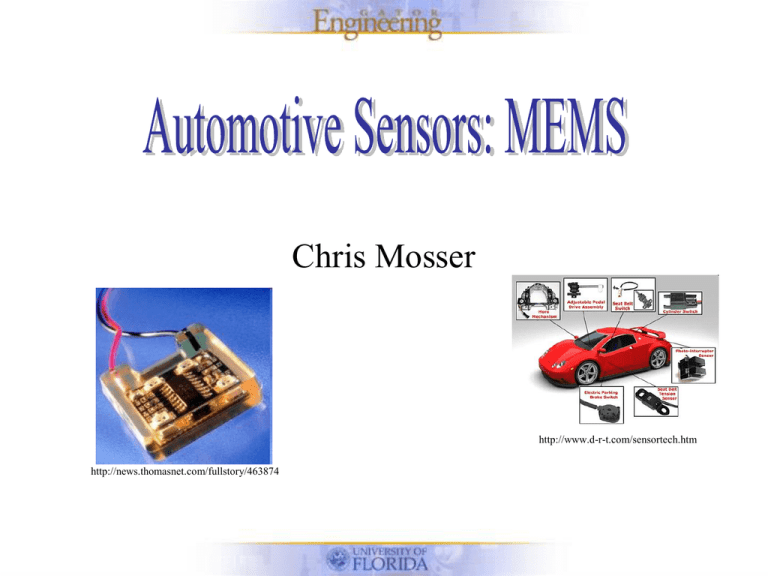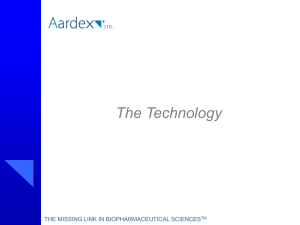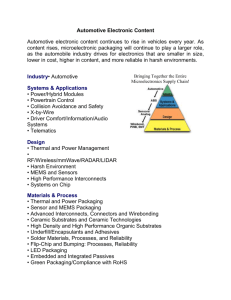Automotive Sensors: MEMS
advertisement

Chris Mosser http://www.d-r-t.com/sensortech.htm http://news.thomasnet.com/fullstory/463874 Outline • • • • • Introduce MEMS Applications Automotive Specific Information Fabrication Packaging What are MEMS? • Micro(small) http://eed.gsfc.nasa.gov/562/SA_MEMs.htm • Electro(electric components/functionality) http://www.memx.com/ • Mechanical(mechanical components/functionality) http://www.memx.com/ • Systems(integrated, system-like functionality) http://www.forbes.com/2008/04/22/mems-apple-nintendo_leadership_clayton_in_jw_0421claytonchristensen_inl_slide.html Where do you find MEMs? • Printers – High DPI inkjets • Projectors • Micro-Mirrors from Texas Instruments • Cell Phones – Knowles Microphones used in most new cell phones • Automobiles Why MEMS • Small – Typically .1-100um feature size http://singularityhub.com/wp-content/uploads/2008/08/red-blood-cells.bmp Red Blood Cells ~ 10um http://www.vendian.org/envelope/dir2/scaling_construct.html Human Hair thickness ~ 50um Why MEMS • Low cost, High yield – Use existing IC fabrication technology – Made primarily on Silicon Wafers http://media-2.web.britannica.com/eb-media/22/78522-004-BB539CA9.jpg Why MEMS • Favorable scaling for a lot of applications – – – – Flow-rate sensors Electrostatics Magnetism Many others • Not all applications – Solar Power – Turbulent Boundary Energy Harvesting Typical Applications • • • • • • Accelerometers Magnetometers Microphones Micro-Fluidics RF-MEMS Bridge to Nanotechnology Automotive MEMS • MEMS Sensors and Actuators used to control various elements of the automobile – Powertrain and Chassis control • Ex: Manifold Air Temperature – Comfort and Convenience • Ex: Air-Temperature Control – Communications • Ex: Wireless Where it Began • 1979 - First recorded use of MEMs in automobiles • Federal emission standards required monitoring the air-tofuel ratio of the engine – Density of air value was needed • Many different sensor technologies were introduced to solve this problem • MAP (manifold absolute pressure) and MAT (manifold air temperature) sensors were developed using MEMS • Silicon based MEMS sensors became the device of choice due to low cost and high yield http://www.quantummatrix.com.my/v1/content/view/231/59/ MAP Sensor Who Developed It • Two groups – Delco Electronics Group(General Motors) • Used piezoresistive sensing – Ford • Used capacitive sensing Piezoresistive Sensors • Use the piezoresistive effect – Applied stress changes resistivity of material Source: IMG(UF) Diaphragm with two embedded piezoresisters Capacitive Sensors • Vary two parameters – Gap – Overlap area • Advantages – Low power – High accuracy – Temperature independent • Important for a lot of automobile applications – Reciprocal • Disadvantages – Parasitic capacitance – Small signal http://www.nanoshift.net/Technology.htm What about Actuators? • Traditionally only sensors were developed for automobiles • Actuators started to become popular as MEMs development costs decreased • Popular actuators include – Microphones – Fuel injection nozzles Fabrication • Use basic IC fabrication – Masks/layers/CVD/oxidation/etc • MEMS specific fabrication – DRIE (Deep reactive ion etch) – SOI (silicon on insulator) General MEMS Packaging • The most important and expensive part of a MEMS sensor/actuator – ~45% of the cost of designing a MEMS device is spent on packaging • Often times packaging constraints will prevent a design from being produced – May require too complex of a package design for realistic implementation • Package can greatly change the response of a device – Sensitivity/Dynamic Range/etc all effected by package Automotive MEMS Packaging • Automotive sensors generally only allowed to have 3 wires connected to them – Minimizes cost • Environment concerns are especially important in automotive applications – Engine heat – High acceleration/deceleration – Humidity Automotive MEMS Summary Precision Engineering By V. C. Venkatesh, Sudin Izman Thank You References • Application of MEMS Technology in Automotive Sensors and Actuators, David Eddy and Douglas Spanks • http://www.img.ufl.edu/ms/eel5225/html/as signments.htm




